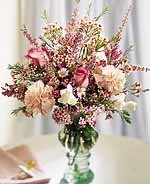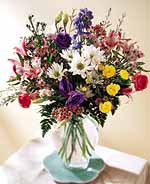Home
Our Loft
Quilts, Gifts, Decorating, Restin' & Relaxin', Pampering
Craftin' Room
Crafts for the
Kid in all of us
Special Occasions
Kids Fun Stuff
Heart of our Home
Recipes, Crafts, Cookbooks, Tips,
Readin' Room
Craft Books, Antiques and Collectibles, Gardening and more
General Store
Stroll the Aisles
From the Porch
Gardening
Helpful Tips
Products
Helpful & Handy Tips
Kitchen, Outside Help, Individual Items
Special Occasions
Crafts & Gifts
About Us Folks
E-Mail
Links
Contact Info
Comfy Country Creations
P.O. Box 10181,
Airdrie, Alberta
T4A 0H5
Phone: 403-912-2645
Fax: 403-912-0543
|
|
Other Related Pages
Spiced Amour
Making Scented Waters
Flower Language Dictionary
History of Flower Giving
Growing the Amaryllis
A Rose Means
History of Flower Giving
Recently at a wedding, the guests were asked to bring a flower to place on the arbor that the bride and groom would walk through. Each bloom was to be accompanied by a small note with best wishes for the new couple. Rather than choose a single bloom, a small nosegay was prepared with a selection of flowers that expressed our wishes. Happy Marriage (Stephanotis), Perfect Love (Tulip), Unity (White & Red Rose) Friendship (Ivy). To convey heartfelt thoughts, the meaning of each flower was written into the note attached to the flowers.
Through the ages, people have given flowers and herbs symbolic meanings. From these meanings, a language of flowers has evolved.
Ancient Greeks dedicated flowers to the gods and crowned people of notoriety with wreaths of blossoms and leaves.
 The French, and English who had been travelling to Turkey in the mid eighteenth century, brought to their homelands the concept of a language of flowers.
During the 1800's, there were books and dictionaries on floriography - the science of sweet things. These books were compiled of drawings of flowers and their meanings.
The arrangements and compositions of flowers and herbs were as significant as the meanings. For example, a marigold alone meant grief; however, if it were brought together with a rose, it expressed the bittersweets or pleasant pains of love.
There were, too, basic grammar rules of floriography as explained in a book that was written in the 1800's called The Language of Flowers. One such rule stated "The expression of every flower may thus be varied by varying its state or position...." In other words, depending on how the flower was drawn it could have several different meanings. From all of the books that were written, the only thing that seemed to be consistent was the fact that they did not always agree on meanings or rules which in turn only added to the romance of flowers.
The French, and English who had been travelling to Turkey in the mid eighteenth century, brought to their homelands the concept of a language of flowers.
During the 1800's, there were books and dictionaries on floriography - the science of sweet things. These books were compiled of drawings of flowers and their meanings.
The arrangements and compositions of flowers and herbs were as significant as the meanings. For example, a marigold alone meant grief; however, if it were brought together with a rose, it expressed the bittersweets or pleasant pains of love.
There were, too, basic grammar rules of floriography as explained in a book that was written in the 1800's called The Language of Flowers. One such rule stated "The expression of every flower may thus be varied by varying its state or position...." In other words, depending on how the flower was drawn it could have several different meanings. From all of the books that were written, the only thing that seemed to be consistent was the fact that they did not always agree on meanings or rules which in turn only added to the romance of flowers.
 In Colonial times, nosegays or tussie mussies, as they were called, were given as gifts. Here too, the different herbs and flowers symbolized different things. Imagine receiving a small bouquet of violets and knowing that the person giving them to you was pledging their loyalty without uttering a word. It was common practice at the beginning of a courtship in the Victorian era for suitors to give their intended a tussie mussie. The types of flowers often changed as the relationship grew allowing the gentleman to say volumes without speaking a word!
Today's society is no different than those of a few hundred years ago. Flowers still hold significant a meaning.
In Colonial times, nosegays or tussie mussies, as they were called, were given as gifts. Here too, the different herbs and flowers symbolized different things. Imagine receiving a small bouquet of violets and knowing that the person giving them to you was pledging their loyalty without uttering a word. It was common practice at the beginning of a courtship in the Victorian era for suitors to give their intended a tussie mussie. The types of flowers often changed as the relationship grew allowing the gentleman to say volumes without speaking a word!
Today's society is no different than those of a few hundred years ago. Flowers still hold significant a meaning.
 Flowers create a special language of their own. The meaning of flowers, herbs and leaves has been written about for centuries. Each book written may proclaim a different meaning, but the meaning of flowers are, after all, whatever you want them to be. The bloom of a dandelion given by a small child holds as much love as a rose given by a admirer.
Various flowers can create interesting conversation. Definitions are dependent on color, size, buds or full blooms and whether they are alone, paired or in bouquets. A lot to remember when trying to pick just the right flower for someone special.
Flowers create a special language of their own. The meaning of flowers, herbs and leaves has been written about for centuries. Each book written may proclaim a different meaning, but the meaning of flowers are, after all, whatever you want them to be. The bloom of a dandelion given by a small child holds as much love as a rose given by a admirer.
Various flowers can create interesting conversation. Definitions are dependent on color, size, buds or full blooms and whether they are alone, paired or in bouquets. A lot to remember when trying to pick just the right flower for someone special.
The above bouquets are available from Gift Tree. Please use link on side panel.
Other Related Pages
Spiced Amour
Making Scented Waters
Flower Language Dictionary
History of Flower Giving
Growing the Amaryllis
A Rose Means
|